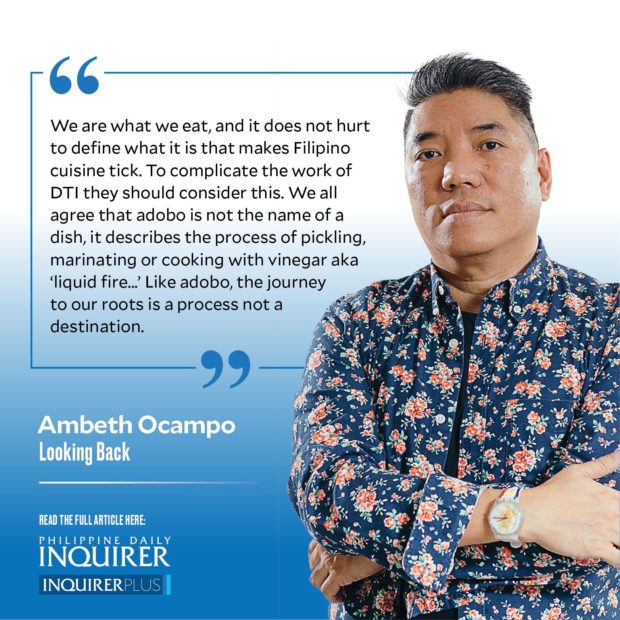Adobo: A process, not a destination
My Philippine history course begins with two central pages from Marcel Proust’s kilometric novel, “À la recherche du temps perdu” (In search of lost time).
A madeleine on the tip of Proust’s tongue triggered the memory of an aunt who dipped madeleines in a cup of tea and fed them to him. Then followed a tsunami of memory that filled seven volumes of a novel that people talked about without ever having read it. My students also submit a one-page paper on food from their childhood. A simple exercise that sets the tone of the course by providing a reflection on time, context to the past, the nature of nostalgia, and how this should never be confused with history.
Article continues after this advertisementAt the root of the ruckus on the Department of Trade and Industry’s (DTI) initiative to define (not standardize) adobo is confusing a legitimate inquiry into the roots of Philippine cuisine with an assault on the freedom to follow our own recipes in loving memory of mothers, grandmothers, and cooks whose adobo shaped our palates, our identities.
When I first lived abroad, my mother sent typewritten recipes to tide me over the inevitable yearning for home and homecooked meals. Not a believer in cooking “oido” or by improvisation, her recipes were painstakingly measured and kitchen-tested ensuring that every dish was replicable. They always looked and tasted the same if you followed instructions without substitution. There was a recipe for adobo in the folder, leche flan too.
Without today’s instant mixes, I cooked from scratch using available ingredients. Sampaloc for sinigang was replaced by tomatoes and lemon. Trout was recommended in place of bangus for paksiw with this memorable tip: “You will know the fish is cooked when the eyes come out.” Dinuguan didn’t need fresh blood, just mashed blood sausages stirred in vinegar, seasoning, and my choice of “laman loob.” Pork belly boiled in salt, garlic, peppercorns, and bay leaf was dried overnight in the fridge (or outside my window in the fall and winter) for carinderia-quality lechon kawali. Beef tapa was sirloin rubbed with salt and pepper, then cured in the fridge. A Thai recipe of pork loin marinated in patis and sugar came closest to tocino. Smoked mackerel stood in for tinapa. I made salted eggs, tea eggs, but failed in my quest for balut.
Article continues after this advertisementMom’s recipes were scanned and distributed during my mother’s wake under the title “Recipes for Traveling Pinoys.” These recipes are now obsolete in the age of fast food. We can order cooked meals online. We can buy ready to eat or heat Pinoy dishes from supermarkets. If the budget is tight, Pinoy sauces in sachets can be carried in your wallet to use over steamed rice. I have since dropped the requirement that all Philippine foreign service personnel should know how to cook a traditional sinigang from scratch. Why labor over straining fresh sampaloc when instant sinigang comes from a packet or cube? Why fumble over tsokolate eh with a batirol when instant Swiss Miss is error-free? When all else fails, YouTube University can teach anyone how to make anything from adobo to an atomic bomb.
Traveling Filipinos need not bring supplies abroad as they did in Rizal’s time or even mine, because Asian stores in the US and Canada are better stocked on Filipino condiments than your neighborhood sari-sari store. On my last trip, US Customs asked Filipinos, “Do you have Magic Sarap? Chicharon?” All the chicken-flavored instant noodles in our luggage were confiscated, but the La Paz Batchoy (with ground chicharon!) ones were allowed in.
We are what we eat, and it does not hurt to define what it is that makes Filipino cuisine tick. That the DTI “standardization” of adobo was thrown into social media to divert our attention from more pressing problems is giving government spin masters too much credit. To complicate the work of DTI they should consider this. We all agree that adobo is not the name of a dish, it describes the process of pickling, marinating or cooking with vinegar aka “liquid fire.” The earliest Tagalog vocabulario compiled in 1613 by Fr. Pedro de San Buenaventura described adobo as “cquilao.” A marinade of salt, vinegar, and chile that was used on meat, fish, deer tripe that was eaten raw. He also uses “quiniqilao” or “quilauin” as a verb to cure deer and carabao meat. If vinegar is the main adobo ingredient historically can we classify: kinilaw, paksiw, and dinuguan as adobo too? Like adobo, the journey to our roots is a process not a destination.
Comments are welcome at aocampo@ateneo.edu

















